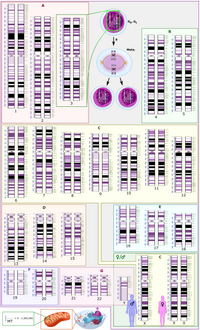
Photo from wikipedia
BackgroundRecent advances in genome editing have facilitated the direct manipulation of not only the genome, but also the epigenome. Genome editing is typically performed by introducing a single CRISPR/Cas9-mediated double-strand… Click to show full abstract
BackgroundRecent advances in genome editing have facilitated the direct manipulation of not only the genome, but also the epigenome. Genome editing is typically performed by introducing a single CRISPR/Cas9-mediated double-strand break (DSB), followed by non-homologous end joining (NHEJ)- or homology-directed repair-mediated repair. Epigenome editing, and in particular methylation of CpG dinucleotides, can be performed using catalytically inactive Cas9 (dCas9) fused to a methyltransferase domain. However, for investigations of the role of methylation in gene silencing, studies based on dCas9-methyltransferase have limited resolution and are potentially confounded by the effects of binding of the fusion protein. As an alternative strategy for epigenome editing, we tested CRISPR/Cas9 dual cutting of the genome in the presence of in vitro methylated exogenous DNA, with the aim of driving replacement of the DNA sequence intervening the dual cuts via NHEJ.ResultsIn a proof of concept at the HPRT1 promoter, successful replacement events with heavily methylated alleles of a CpG island resulted in functional silencing of the HPRT1 gene. Although still limited in efficiency, our study demonstrates concurrent epigenome and genome editing in a single event.ConclusionsThis study opens the door to investigations of the functional consequences of methylation patterns at single CpG dinucleotide resolution. Our results furthermore support the conclusion that promoter methylation is sufficient to functionally silence gene expression.
Journal Title: BMC Biology
Year Published: 2019
Link to full text (if available)
Share on Social Media: Sign Up to like & get
recommendations!